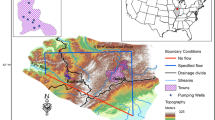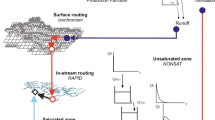Abstract
Travel times and flow paths of groundwater from its recharge area to drinking-water production wells will govern how the quality of pumped groundwater responds to contaminations. Here, we studied the 180 km2 Ammer catchment in southwestern Germany, which is extensively used for groundwater production from a carbonate aquifer. Using a 3-D steady-state groundwater model, four alternative representations of discharge and recharge were systematically explored to understand their impact on groundwater travel times and flow paths. More specifically, two recharge maps obtained from different German hydrologic atlases and two plausible alternative discharge scenarios were tested: (1) groundwater flow across the entire streambed of the Ammer River and its main tributaries and (2) groundwater discharge via a few major springs feeding the Ammer River. For each of these scenarios, the groundwater model was first calibrated against water levels, and subsequently travel times and flow paths were calculated for production wells using particle tracking methods. These computed travel times and flow paths were indirectly evaluated using additional data from the wells including measured concentrations of major ions and environmental tracers indicating groundwater age. Different recharge scenarios resulted in a comparable fit to observed water levels, and similar estimates of hydraulic conductivities, flow paths and travel times of groundwater to production wells. Travel times calculated for all scenarios had a plausible order of magnitude which were comparable to apparent groundwater ages modelled using environmental tracers. Scenario with groundwater discharge across the entire streambed of the Ammer River and its tributaries resulted in a better fit to water levels than scenario with discharge at a few springs only. In spite of the poorer fit to water levels, flow paths of groundwater from the latter scenario were more plausible, and these were supported by the observed major ion chemistry at the production wells. We concluded that data commonly used in groundwater modelling such as water levels and apparent groundwater ages may be insufficient to reliably delineate capture zones of wells. Hydrogeochemical information relating only indirectly to groundwater flow such as the major ion chemistry of water sampled at the wells can substantially improve our understanding of the source areas of recharge for production wells.






Similar content being viewed by others
References
Alley WM, Healy RW, LaBaugh JW, Reilly TE (2002) Flow and storage in groundwater systems. Science 296:1985–1990
Armbruster V, Leibundgut C (2001) Method for spatially distributed modelling of evapotranspiration and fast runoff components to describe large-scale groundwater recharge. IAHS Publ 269:3–10
Barthel R, Jagelke K, Götzinger J, Gaiser T, Printz A (2008) Aspects of choosing appropriate concepts for modeling groundwater resources in regional integrated water resources management—examples from the Neckar (Germany) and Oueme catchment (Benin). Phys Chem Earth 33:92–114
Bauer S, Liedl R, Sauter M (2003) Modeling of karst aquifer genesis: influence of exchange flow. Water Resour Res 39(10):WR002218
Chiang WH (2005) 3D-groundwater modeling with PMWIN. Springer, Berlin/Heidelberg/New York
Doherty J (2004) PEST: model independent parameter estimation. Watermark Numerical Computing, Brisbane
Githui F, Selle B, Thayalakumaran T (2012) Recharge estimation using remotely sensed evapotranspiration in an irrigated catchment in southeast Australia. Hydrol Process 26:1379–1389
Gleeson T, Novakowski K, Cook PG, Kyser TK (2009) Constraining groundwater discharge in a large watershed: integrated isotopic, hydraulic, and thermal data from the Canadian shield. Water Resour Res 45(8):W08402
Gräbe A, Rink K, Fischer T, Sun F, Wang W, Rödiger T, Siebert C, Kolditz O (2013) Numerical analysis of the groundwater regime in the western dead sea escarpment. Environ Earth Sci. doi:10.1007/s12665-012-1795-8
Grathwohl P, Rügner H, Wöhling T, Osenbrück K, Schwientek M, Gayler S, Wollschläger U, Selle B, Pause M, Delfs J-O, Grzeschik M, Weller U, Ivanov M, Cirpka OA, Maier U, Kuch B, Nowak W, Wulfmeyer V, Warrach-Sagi K, Streck T, Attinger S, Bilke L, Dietrich P, Fleckenstein JH, Kalbacher T, Kolditz O, Rink K, Samaniego L, Vogel H-J, Werban U, Teutsch G (2013) Catchments as reactors—a comprehensive approach for water fluxes and solute turn-over. Environ Earth Sci 69(2). doi:10.1007/s12665-013-2281-7
Guadagnini A, Franzetti S (1999) Time-related capture zones for contaminants in randomly heterogeneous formations. Ground Water 37(2):253–260
HAD (2012) Hydrologischer Atlas von Deutschland. http://www.hydrology.uni-freiburg.de/forsch/had/. Accessed 26 July 2012
Harrar WG, Sonnenborg TO, Henriksen HJ (2003) Capture zone, travel time, and solute-transport predictions using inverse modeling and different geological models. Hydrogeol J 11(5):536–548
Harress HM (1973) Hydrogeologische Untersuchungen im Oberen Gäu. Dissertation, University of Tübingen, Tübingen
Hydroisotop (2004) Ergebnisse der hydrochemischen und isotopenhydrologischen Bestandsaufnahme im Gebiet Ammertal-Rottenburg. Hydroisotop, Schweitenkirchen
Kolditz O, Bauer S, Bilke L, Böttcher N, Delfs JO, Fischer T, Görke UJ, Kalbacher T, Kosakowski G, McDermott CI, Park CH, Radu F, Rink K, Shao H, Shao HB, Sun F, Sun YY, Singh AK, Taron J, Walther M, Wang W, Watanabe N, Wu Y, Xie M, Xu W, Zehner B (2012) OpenGeoSys: an open-source initiative for numerical simulation of thermo-hydro-mechanical/chemical (THM/C) processes in porous media, Environ Earth Sci 67:589–599. doi:10.1007/s12665-012-1546-x
Landesamt für Umweltschutz Baden-Württemberg (2002) Fortschreibung Hydrogeologische Karte und regionales Grundwassermodell “Heilbronner Mulde”. Landesamt für Umweltschutz Baden-Württemberg, Karlsruhe
Małoszewski P, Zuber A (1982) Determining the turnover time of groundwater systems with the aid of environmental tracers. 1. Models and their applicability. J Hydrol 57:207–231
Panagopoulos G (2012) Application of MODFLOW for simulating groundwater flow in the Trifilia karst aquifer, Greece. Environ Earth Sci 67:1877–1889. doi:10.1007/s12665-012-1630-2
Parkhurst DL, Appelo CAJ (1999) User’s guide to PHREEQC (Version 2)—a computer program for speciation, batch-reaction, one-dimensional transport, and inverse geochemical calculations. USGS, Reston
Plümacher J (1999) Kalibrierung eines regionalen Grundwasserströmungsmodells mit Hilfe von Umwetltisotopeninformation. Dissertation, ETH Zürich, Zurich
Praamsma T, Novakowski K, Kyser K, Hall K (2009) Using stable isotopes and hydraulic head data to investigate groundwater recharge and discharge in a fractured rock aquifer. J Hydrol 366(1–4):35–45
Refsgaard JC (2011) Review of strategies for handling geological uncertainty in groundwater flow and transport modeling. Adv Water Resour 36:36–50
Reuther CD (1973) Zur Schichtlagerung und Tektonik im Oberen Gäu. Master thesis, University of Tübingen, Tübingen
Rink K, Kalbacher T, Kolditz O (2012) Visual data management for hydrological analysis. Environ Earth Sci 65(5):1395–1403
Rink K, Fischer T, Selle B, Kolditz O (2013) A data exploration framework for validation and setup of hydrological models. Environ Earth Sci. doi:10.1007/s12665-012-2030-3
Sauter M, Kovács A, Geyer T, Teutsch G (2006) Modellierung der Hydrodynamik von Karstgrundwasserleitern—Eine Übersicht. Grundwasser 11(3):143–156
Schwientek M, Osenbrück K, Fleischer M (2013) Investigating hydrological drivers of nitrate export dynamics in two agricultural catchments in Germany using high-frequency data series. Environ Earth Sci. doi:10.1007/s12665-013-2322-2
Sun F, Shao H, Kalbacher T, Wang W, Yang Z, Huang Z, Kolditz O (2012) Groundwater drawdown at Nankou site of Beijing plain: model development and calibration. Environ Earth Sci 64(5):1323–1333
Villinger E (1982) Grundwasserbilanzen im Karstaquifer des Oberen Muschelkalks im Oberen Gäu (Baden-Württemberg). Geologisches Jahrb: Reihe C 32:43–61
WaBoA (2001) Wasser- und Bodenatlas Baden-Württemberg. http://www.hydrology.uni-freiburg.de/forsch/waboa/. Accessed 26 July 2012
Ye M, Pohlmann KF, Chapman JB, Pohll GM, Reeves DM (2010) Model-Averaging Method for Assessing Groundwater Conceptual Model Uncertainty. Ground Water 48(5):716–728
Zanini L, Novakowski KS, Lapcevie P, Bickerton GS, Voralek J, Talbot C (2000) Ground water flow in a fractured carbonate aquifer inferred from combined hydrogeological and geochemical measurements. Ground Water 38(3):350–360
Acknowledgments
This work was supported by a grant from the Ministry of Science, Research and Arts of Baden-Württemberg (AZ Zu 33-721.3-2) and the Helmholtz Center for Environmental Research, Leipzig (UFZ). We would like to thank Dr. Marc Schwientek and Dr. Karsten Osenbrück (Water & Earth System Science), Bernhard Keim (engineering company kup), Andreas Steinacker (consulting company BGU) and Inge Neeb (city council of Sindelfingen) for technical discussions. We also thank the Ammertal-Schönbuchgruppe (local water supplier) for providing data, Igor Pavlovskiy for providing Fig. 5 and analysing water quality data using PHREEQC and Dr. Wenqing Wang and Dr. Jens-Olaf Delfs for OGS support. We are grateful for the detailed comments provided by 3 reviewers based on which the manuscript could be significantly improved.
Author information
Authors and Affiliations
Corresponding author
Rights and permissions
About this article
Cite this article
Selle, B., Rink, K. & Kolditz, O. Recharge and discharge controls on groundwater travel times and flow paths to production wells for the Ammer catchment in southwestern Germany. Environ Earth Sci 69, 443–452 (2013). https://doi.org/10.1007/s12665-013-2333-z
Received:
Accepted:
Published:
Issue Date:
DOI: https://doi.org/10.1007/s12665-013-2333-z




